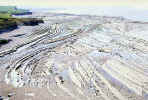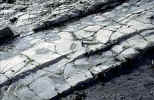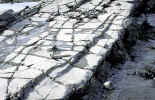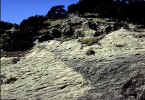| 
| Foreshore at lowtide, Somerset, U.K. Excellent exposures of faults in both plan view and cross section provide details of 2-D and 3-D fault geometries, and an in-depth look at fault zone character. |
| 
| Normal fault in sand/shale sequence, Salt Flat Graben, Texas. The top of the massive sand (left) is also visible in the hanging-wall in the lower right portion of the photograph. Gouge, fault induced fractures, and gypsum mineralization are the physical characteristics that will control seal behavior here. The upper part of the fault zone is a sand/shale juxtaposition; the lower part a sand/sand juxtaposition. Fault Plane Profiles provide necessary information to understand juxtaposition relationships across the fault. |
| 
| Normal fault in Mesozoic limestone/shale and marl sequence, Somerset, UK. This is a classic example of "smear" gouge with ductile brown marls and black shales being "smeared" into the fault zone. Several blocks of more brittle limestone are also incorporated in the gouge. Note the classic lenticular structure visible at all scales. "Smear gouge" is comprised of many shear bounded lentils. One such lentil can be seen in the upper right in the process of being detached from the footwall. |
|  | Normal fault in Permo-Carboniferous section of the onshore Cleveland Basin, UK. The footwall of gray shale is juxtaposed with sandstones in the hanging-wall. A layer of light gray clay and black coal has been "smeared" into the fault zone. The gouge includes both the very brittle coal and ductile shale. A damage zone extends into the sandstone. Cataclasis reduces sandstone permeability. |
|  | Normal fault in Jurassic shale/limestone sequence, Somerset, UK. The gouge layer consists almost entire of shale with only a small amount of the more brittle limestones. The gouge zone is approximately 1 m thick. Note that even though reservoirs may be juxtaposed across the fault, a thick layer of shale gouge provides a seal. The shale gouge is comprised of numerous shear-bounded lentils that have been translated along the fault. |
| 
| Classic "smear" gouge along a normal fault in a Jurassic shale/limestone sequence, Somerset, UK. Both ductile black shales and brittle gray limestones have been incorporated into the fault gouge. The ratio of the permeable/impermeable lithologies determine the sealing behavior of the fault. Individual shale beds can be traced from their position in the footwall and hanging-wall along the fault gouge zone. |
| 
| Normal faults in Jurassic limestone bed, Somerset, UK. Note relay zone with ramp formed between two fault tip lines. Compare with following photograph. Fault nucleation, growth & evolution control fluid migration, seal behavior, and gouge formation. |
| 
| Normal faults in Jurassic limestone bed, Somerset, UK. Note relay zone formed between two fault tip lines. The two faults have merged with increasing displacement. Compare with preceding photograph. A relay zone has evolved from a simple ramp through which leakage occurs to a more complex faulted ramp with progressively less opportunity for leakage. Most faults are comprised of numerous linked segments. These early linkage zones (both dilational & contractional) are incorporated into the main fault. Extension fractures, compressive shear fractures or deformation bands, transverse faults, and mineralization are all concentrated in these linkage zones and later translated along the fault with progressive shear. These are primary controls on seal behavior. |
| 
| Normal fault in fine-grained sandstone/siltstone, Tertiary, Isle of Wight. Gouge zone consists of sandstone/siltstone derived from footwall and hanging-wall. This gouge is sand-prone, has a high SGR, and, based upon observations of faults in producing field with similar characteristics, would cross leak hydrocarbons. Coin at center left for scale. |
| 
| Normal fault in Permo-Triassic section on the Isle of Arran, along the west coast of Scotland. Massive, New Red Sandstones show "smearing" of light colored sand layer in hanging-wall (left). The same light colored sand layer appears in the footwall (upper right). Despite "smearing" gouge is dominated by cataclasis and development of deformation bands. |
| 
| Fault in Arroyo Grande Field, California. Sealing fault separates black, asphalt saturated sands on right from light-gray "water-wet" sands on left. Oil flowed around fault termination in lower right of photograph. |
|  | Dense network of deformation bands (white) in asphalt-saturated sandstone, Arroyo Grande Field, California. |












